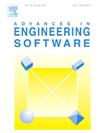基于运动球体的复杂机构多目标优化:在悬架弹性运动学中的应用
IF 5.7
2区 工程技术
Q2 COMPUTER SCIENCE, INTERDISCIPLINARY APPLICATIONS
引用次数: 0
摘要
本文提出了一种新的迭代方法,称为移动球体(MS),用于解决涉及三维机构的多目标设计优化问题。该方法适用于大多数设计变量属于三维欧几里德空间的问题。MS方法能够有效地探索设计空间并识别最优解所在的区域,从而使最优解具有清晰的空间表示。本文将质谱法应用于某汽车悬架系统的弹性运动学优化。在参考悬架的球面邻域内寻找悬架节点的最佳位置。这既保留了机构的运动兼容性,又便于通过参考悬架的迭代更新探索设计空间。采用严格的k-最优性度量,在帕累托最优集中引入层次排序,对最优设计方案进行排序。在悬架试验用例中,考虑相似的计算时间,将移动球法逼近的pareto最优集与参数空间调查和多目标优化排序遗传算法(KEMOGA)方法逼近的pareto最优集进行了比较。移动球体法产生了更精确的帕累托最优集近似值。本文章由计算机程序翻译,如有差异,请以英文原文为准。
Multi-objective optimisation of complex mechanisms using Moving Spheres: An application to suspension elasto-kinematics
This paper presents a new iterative method, called Moving Spheres (MS), for solving multi-objective design optimisation problems involving three-dimensional mechanisms. The method is suited to problems in which most of the design variables belong to the three-dimensional Euclidean space. MS method is able to explore efficiently the design space and identifies the regions where the optimal solutions are located, resulting in a clear spatial representation of optimal solutions. In this paper, MS method is applied to the elasto-kinematic optimisation of an automotive suspension system. The optimal locations of suspension joints are sought within spherical neighbourhoods of a reference suspension. This preserves the kinematic compatibility of the mechanism and facilitates the exploration of the design space through iterative updates of the reference suspension. The rigorous -optimality metric, which introduces a hierarchical sorting in the Pareto-optimal set, is employed to rank optimal design solutions. In the suspension test case, the Pareto-optimal set of approximated through Moving Spheres method is compared with the Pareto-optimal sets resulting from Parameter Space Investigation and multi-objective optimisation Genetic Algorithm with sorting (KEMOGA) methods, considering similar computational time. Moving Spheres method yields a more accurate approximation of the Pareto-optimal set.
求助全文
通过发布文献求助,成功后即可免费获取论文全文。
去求助
来源期刊

Advances in Engineering Software
工程技术-计算机:跨学科应用
CiteScore
7.70
自引率
4.20%
发文量
169
审稿时长
37 days
期刊介绍:
The objective of this journal is to communicate recent and projected advances in computer-based engineering techniques. The fields covered include mechanical, aerospace, civil and environmental engineering, with an emphasis on research and development leading to practical problem-solving.
The scope of the journal includes:
• Innovative computational strategies and numerical algorithms for large-scale engineering problems
• Analysis and simulation techniques and systems
• Model and mesh generation
• Control of the accuracy, stability and efficiency of computational process
• Exploitation of new computing environments (eg distributed hetergeneous and collaborative computing)
• Advanced visualization techniques, virtual environments and prototyping
• Applications of AI, knowledge-based systems, computational intelligence, including fuzzy logic, neural networks and evolutionary computations
• Application of object-oriented technology to engineering problems
• Intelligent human computer interfaces
• Design automation, multidisciplinary design and optimization
• CAD, CAE and integrated process and product development systems
• Quality and reliability.
 求助内容:
求助内容: 应助结果提醒方式:
应助结果提醒方式:


